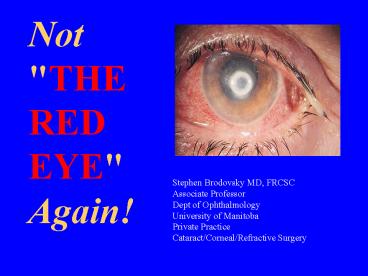Not "THE RED EYE" Again - PowerPoint PPT Presentation
1 / 57
Title:
Not "THE RED EYE" Again
Description:
Not "THE RED EYE" Again – PowerPoint PPT presentation
Number of Views:216
Avg rating:3.0/5.0
Title: Not "THE RED EYE" Again
1
Not"THE REDEYE"Again!
Stephen Brodovsky MD, FRCSC Associate
Professor Dept of Ophthalmology University of
Manitoba Private Practice Cataract/Corneal/Refract
ive Surgery
2
Ocular History Examination
Visual Acuity Pupils Motility Anterior segment
(cornea conjunctiva) Posterior
segment Confrontation Fields Intraocular Pressure
3
Usual RED EYE Lecture
- INFECTIOUS VIRAL vs BACTERIAL
- ALLERGIC
- DRY EYE
- TOXIC
- SUBCONJUNCTIVAL HEMORRHAGE
- IRITIS
- EPISCLERITIS
- ACUTE ANGLE CLOSURE GLAUCOMA
4
Photophobia
5
? Pupil Size? Location of Injection
6
(No Transcript)
7
What is your provisional Diagnosis ?
8
If painful, usually not pink eye
- Differential Diagnosis Includes
- Corneal Abrasion
- Bacterial or Herpetic Corneal Ulcer
- Episcleritis or Scleritis
- Acute Angle Closure Glaucoma
9
Keratic Precipitates
10
Keratic Precipitates
11
Iritis Treatment
- Topical Steroid drops (up to q1h) and cycloplegic
drop eg Homatropine 2 - Ophthalmic referral
- Steroid cycloplegic drops are tapered over 1
month - Check intraocular pressure
- If recurrent consider medical workup
12
Why is the patient having difficulty working ?
- Cycloplegic drops interfere with near vision
- Important to prevent posterior synechiae
(adhesions of iris to lens)
13
Photophobia /or Ciliary Injection
- Indicates corneal and/or anterior chamber
inflammation - Always rule-out corneal staining defect with
fluorescein - eg abrasion, herpes dendrite, corneal ulcer
14
Photophobia Ciliary Injection
Corneal Abrasion
Herpes Simplex
Corneal Ulcer
15
Corneal Ulcers Rosacea Blepharitis
16
Contact lens wearer corneal ulcer
ALWAYS ASK ABOUT CONTACT LENS WEAR!!!
17
Chronic Irritation
18
What is your provisional Diagnosis ?
19
History
- Ask about
- Dry mouth (Sjogrens syndrome)
- Connective tissue disease
- Systemic medication that may contribute to dry
eye symptoms
20
Dry Eyes
- Common ocular condition
- Incidence increases with age
- History is the most important clue to Dx
- Treatment may be initiated by family doctor
- Ophthalmic consultation in refractory situations
21
Keratitis in Advanced Dry Eye
22
Schirmer Test
Tear production measured
23
Rule-out Blepharitis
Erythema of lid margin
Scales on Lashes
Loss of Cilia
Frequently co-exists with dry eye
24
Dry Eye Treatment
- Artificial tears up to 1 drop qid (consider
cooling drops) - Ointment at bedtime
- Humidifier
- Preservative free tears up to q1h
- Punctal occlusion (silicone plugs) or cautery
- Oral pilocarpine (Salogen)
- Restasis (topical cyclosporin only available
thru HPB)
25
(No Transcript)
26
Acute Red Eye
27
(No Transcript)
28
(No Transcript)
29
Red Eye
- No change in vision
- No photophobia
- No pain
- No staining of cornea
30
What is your provisional Diagnosis ?
31
Provisional Diagnosis
Subconjunctival hemorrhage
? Trauma
? Elevated BP
? Blood Clotting
? Valsalva Maneuver
32
Subconjunctival Hemorrhage Management
- Reassure patient that blood will reabsorb
- Referral not necessary
- Clotting status to be evaluated to make sure
Coumadin dosage satisfactory - Be sure that BP is OK
33
Red Eye with Discharge
34
(No Transcript)
35
What is your provisional Diagnosis ?
36
Clinical Pearls
- Most cases of infection are secondary to virus
(tearing, enlarged preauricular lymph node) - If need fingers to open lids in am this is
suggestive of bacterial conjunctivitis - Be suspicious of unilateral red eye Trichiasis ?
Foreign Body ? Dacryocystitis ?
37
Differential Diagnosis
Lacrimal System Obstruction
38
Bacterial Conjunctivitis Treatment
- Broad-spectrum fluoroquinolone antibiotic is
effective for suspected bacterial case 1
drop qid for 7 to 10 days - Warm compresses to clean lids of discharge
- Cultures usually not required unless recurrent or
persistent - Ciprofloxacin or Erythromycin available as an
ointment for children
39
Bacterial Conjunctivitis Treatment
- Lancet. 2005 Jul 2-8366(9479)37-43
- Chloramphenicol treatment for acute infective
conjunctivitis in children in primary care a
randomised double-blind placebo controlled trial - Rose PW et al, Oxford UK
- Placebo vs Chloramphenicol gtts
- 83 vs 86 cure rates at 7 days
40
Bacterial Conjunctivitis Treatment
- Conclusion
- Most children with acute infective conjunctivitis
will get better by themselves and do not need
treatment with an antibiotic
41
Chronic Red Eye
42
(No Transcript)
43
Chronic Conjunctivitis
Differential Diagnosis
- Allergic or Toxic reaction to eye drops
- Dry eyes (dryness, irritation, burning)
- Blepharitis (scales on lashes, erythema of lid
margin) - Contact lens wear!!
44
Diagnosis ?
Chronic Conjunctivitis Secondary to toxic or
allergic reaction to topical medication
45
Management
- Alphagan eye drops discontinued
- Redness resolved in one week
- Ophthalmologist to start another anti-glaucoma
medication
46
Toxic Reaction to Eye Drops
- Common scenario is treatment of conjunctivitis
with gentamicin eye drops - No improvement after one week, new medication is
prescribed - Toxic keratopathy results
- Use antibiotics for 1 week, 1 drop qid -gt If no
improvement -gt Refer
47
Itching
48
What is your provisional Diagnosis ?
49
Allergy
Mast cells
Factors Released Histamine, Chemotactic factors,
Prostaglandin synthesis
50
Management of Ocular Allergy
- Cold compresses
- Mast cell stabilizer anti-histamine eg Patanol
or Zaditor bid - Systemic antihistamines (Can Have Drying Effect
on Eyes Natural DefenderTear Film) - Frequent showers to remove allergens from hair,
skin, etc. - If highly symptomatic referral to ophthalmologist
- Mild topical steroid (FML)
- Restasis (topical cyclosporin)
51
Red Eye Summary
Photophobia Chronic Irritation Acute Red Eye Red
Eye with Discharge Chronic Red Eye Itching
52
Decreased Vision Post-Cataract Surgery
53
History of Perfect Vision then Unable to
Distinguish Material in first week after Surgery
54
(No Transcript)
55
What is your provisional Diagnosis ?
56
What is your management ?
Referral to ophthalmologist in
- 1 week
- 2 days
- 1 day
- Same day
57
Complications Post-Cataract Surgery
- Endophthalmitis
- Retinal detachment
- Macular edema
- Corneal edema































